NCERT Exemplar Solutions: Reproduction in Animals | Science Class 8 PDF Download
| Table of contents |

|
| Multiple Choice Questions |

|
| Very Short Answer Questions |

|
| Short Answer Questions |

|
| Long Answer Questions |

|
Multiple Choice Questions
Q.1. Sets of reproductive terms are given below. Choose the set that has an incorrect combination.
(a) sperm, testis, sperm duct, penis
(b) menstruation, egg, oviduct, uterus
(c) sperm, oviduct, egg, uterus
(d) ovulation, egg, oviduct, uterus
Ans: c
Explanation:
Sperm is male gamete, the egg is female gamete, oviduct and uterus are part of the female reproductive system. Hence option c) is an incorrect combination.
Q.2. In humans, the development of the fertilised egg takes place in the
(a) ovary
(b) testis
(c) oviduct
(d) uterus
Ans: d
Explanation:
The development of the fertilised egg takes place in the uterus. Embryo gets embedded in the wall of the uterus for development by implantation.
Q.3. In the list of animals given below, the hen is the odd one out.
human being, cow, dog, hen
The reason for this is
(a) it undergoes internal fertilisation.
(b) it is oviparous.
(c) it is viviparous.
(d) it undergoes external fertilisation.
Ans: b
Explanation:
The hen is oviparous, it lays the egg and the young one gets hatched later. Rest of the animals provided are viviparous. They give birth to young ones after they are developed completely.
Q.4. Animals exhibiting external fertilisation produce a large number of gametes. Pick the appropriate reason from the following.
(a) The animals are small in size and want to produce more offsprings.
(b) Food is available is plenty of water.
(c) To ensure a better chance of fertilisation.
(d) Water promotes the production of a large number of gametes.
Ans: c
Explanation:
Because they release gametes in water chances of getting washed away by water, wind and rain are more. Hence To ensure better chance of fertilisation. A large number of gametes are produced by Animals exhibiting external fertilization.
Q.5. Reproduction by budding takes place in
(a) hydra
(c) paramecium
(b) amoeba
(d) bacteria
Ans: a
Explanation:
Paramecium, Amoeba and bacteria reproduce by binary fission. Hydra reproduces by budding where a bud detaches from the parent which grows into a complete organism.
Q.6. Which of the following statements about reproduction in humans is correct?
(a) Fertilisation takes place externally.
(b) Fertilisation takes place in the testes.
(c) During fertilisation, egg moves towards the sperm.
(d) Fertilisation takes place in the human female.
Ans: d
Explanation:
Male gametes are introduced into a female’s body through the vagina. Sperm reach uterus through the oviduct. At uterus, egg gets fertilized by sperm to form a zygote.
Q.7. In human beings, after fertilisation, the structure which gets embedded in the wall of uterus is
(a) ovum
(b) embryo
(c) foetus
(d) zygote
Ans: b
Explanation:
Egg fuses with sperm to form the zygote which will divide to form a clump of hundreds of cells which form the embryo. The process of moving down embryo from oviduct into the uterus is called as implantation.
Q.8. Aquatic animals in which fertilisation occurs in water are said to be:
(a) viviparous without fertilisation.
(b) oviparous with external fertilisation.
(c) viviparous with internal fertilisation.
(d) oviparous with internal fertilisation.
Ans: b
Explanation:
Aquatic animals lay eggs and release sperms into the water for fertilization to take place. Young one is formed outside the body hence it is called external fertilization.
Q.9. After fertilisation, the resulting cell which gives rise to a new individual is the
(a) embryo
(b) ovum
(c) foetus
(d) zygote
Ans: d
Explanation:
The zygote is the beginning of the formation of a new individual. All the multicellular organisms start their life from single-celled zygote.
Q.10. In human beings, the correct sequence of events during reproduction is
(a) gamete formation, fertilisation, zygote, embryo
(b) embryo, zygote, fertilisation, gamete formation
(c) fertilisation, gamete formation, embryo, the zygote
(d) gamete formation, fertilisation, embryo, the zygote
Ans: a
Explanation:
In humans, male gametes fuse with female gametes to fertilise in the female ovary. Fertilised sperm and egg form zygote which will divide repeatedly to form the embryo.
Very Short Answer Questions
Q.11. Although 2 cells called gametes fuse, the product formed is a single cell called the zygote. Justify.
Ans: The sperm and the ovum merge during the fertilization process. In order to produce the zygote, the contents of the sperm cell are transported into the egg. Hence, the product is a single-celled zygote.
Q.12. Stages in the lifecycle of silkworm are given below. Write them in sequential order.
pupa, silkworm, egg, silkmoth
Ans: The following is the right order of phases in the silkworm's life cycle: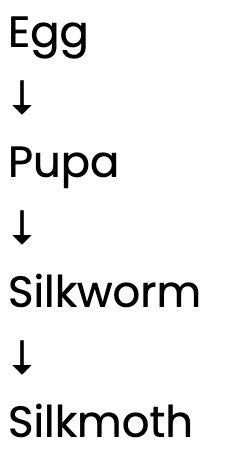
Q.13. What is the importance of reproduction?
Ans: Reproduction ensures the continuation of species from generation to generation and saves the populations from extinction..
Q.14. In markets, eggs of birds are available but never eggs of dogs. Why?
Ans: Because the dog is viviparous. It does not lay an egg. It gives birth to a new one.
Q.15. The eggs of frogs do not have shells for protection, yet they are safe in the water. How?
Ans: The eggs are covered with a jelly-like substance by the female frog, which causes them to float to the water's surface and protects them from damage.
Short Answer Questions
Q.16. Fill up the blanks with the terms given below:
boy, asexual, binary, single, nucleus
Amoeba is a ___________ celled organism. It reproduces by ___________ reproduction. The process of reproduction begins by the division of its ___________ into two. This is followed by the division of its ___________ into two. This type of reproduction is called ___________ fission.
Ans:
Amoeba is a single-celled organism. It reproduces by asexual reproduction. The process of reproduction begins with the division of its nucleus into two. This is followed by the division of its body into two. This type of reproduction is called binary fission.
Q.17. The term metamorphosis is not used while describing human development. Why?
Ans: Metamorphosis is a biological process in which an organism's form changes dramatically from one stage to the next in its life cycle, such as from the caterpillar to pupa and pupa to adult. Metamorphosis occurs in a variety of insects, fishes, amphibians, and many more. Metamorphosis is not something that humans go through.
Q.18. Mother gives birth to a baby but the baby has characters of both parents. How is this possible?
Ans: Due to sexual reproduction, the child possesses the characteristics of both the mother and father. The process of sexual reproduction involves the fertilization of male and female gametes, which results in the development of a zygote.
As a result of the two parents' genetic material being combined, a new creature is created, and the child possesses the characteristics of both parents.
Q19. How is reproduction in hydra different from that in amoeba?
Ans: Hydra reproduces by budding where a bud detaches from the parent which grows into a complete organism. Whereas amoeba reproduces by binary fission. The process of reproduction begins with the division of its nucleus into two. This is followed by the division of its body into two.
Q.20. State whether the following statements are True or False. If false, correct the statement:
(a) External fertilisation can occur both in water and on land.
(b) The eggs of fish are covered by hard shells for protection.
(c) The human egg has a head, middle piece and tail.
(d) In adult human females, a single mature egg is released into an oviduct every month.
Ans:
- False- External fertilisation can occur only in water.
- False- eggs of fish are covered by jelly-like substance for protection.
- False- Human sperm has a head, middle piece and tail.
- True
Q.21. Why do only male gametes have a tail?
Ans: Because sperm need to be motile to reach the non-motile egg in the ovary of the female. The tail helps the sperm swim through the female's reproductive tract and into the oviduct.
Q.22. What does Figure represent?

Ans: This figure represents binary fission in the amoeba which involves the division of its nucleus into two followed by the division of its body into two.
Q.23. Observe the figure given as Figure and answer the questions that follow.
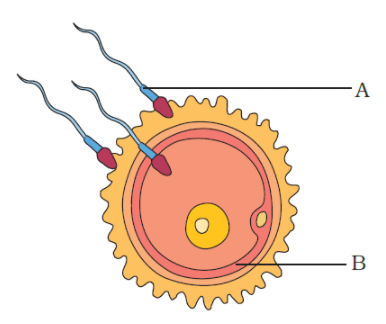
(a) Label A and B.
(b) Identify the process.
(c) What happens during this process and what is formed?
Ans:
(a) A-sperm; B-ovum (egg)
(b) Fertilisation
(c) Sperm nucleus fuses with the egg nucleus to form the zygote.
Long Answer Questions
Q.24. How can we say that fish exhibits external fertilisation?
Ans: In an aquatic environment, external fertilization keeps the eggs from drying out. Male and female fish both release eggs and sperm into the sea. Sperm swim around in the water at random and come into contact with the eggs. The sperm nucleus travels into the egg and unites with it. External fertilization happens when fertilization takes place outside the female body, in water. Given that a vast majority of fish (>95 percent) experience external fertilization, it's only natural that the eggs develop outside the mother's body.
Q.25. After observing Figure answer the following.

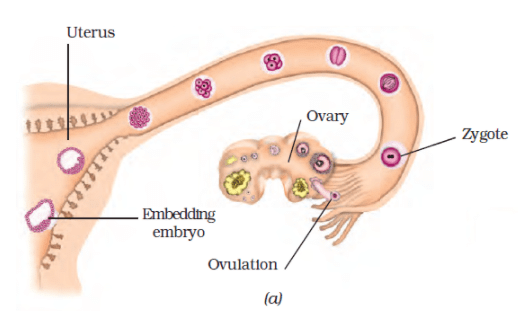
a) Read the following statements and label them in the figure:
(i) The part which produces female gametes.
(ii) The part where the development of the baby takes place.
(iii) The part through which the developing embryo passes to reach the uterus.
Ans: a)
(i) Ovary
(ii) Uterus
(iii) Oviduct
b) Explain the future development of the embryo that would take place after it gets embedded in the uterus.
Ans: The developing embryo gets embedded in the wall of the uterus for further development. The development of the embryo occurs in the uterus. It gradually develops body parts such as hands, legs, head, eyes, ears, etc. The foetus is the stage of the embryo in which all the body parts can be identified. 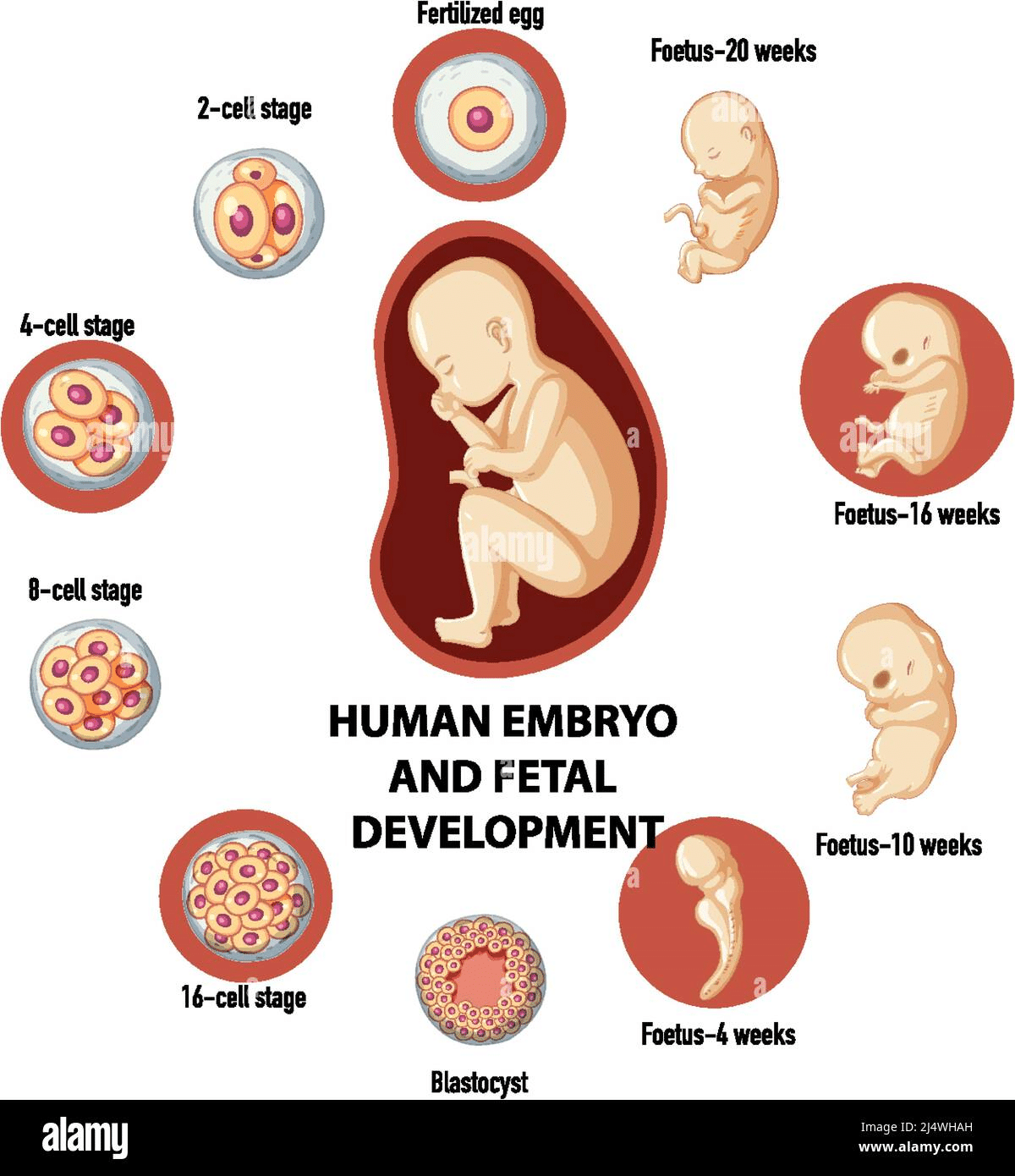
Q.26. Hens and frogs are both oviparous exhibiting different types of fertilisation. Explain.
Ans: Internal fertilization occurs in hens. Inside the body, the fertilized egg grows into an embryo. The embryonic development of a chick, on the other hand, occurs outside the body.
Frogs are oviparous, which means that both zygote fertilization and embryo development take place outside the body.
Q27. Observe the following figures.
(a)
(b)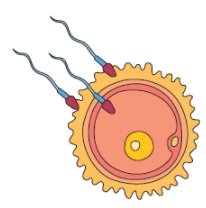
(c)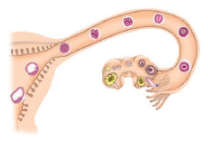
(d)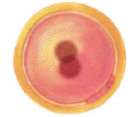
(i) Identify the stages a to d in Figure during the development of the human baby.
(ii) Arrange the stages in the correct sequence of development.
(iii) Explain the development that takes place in any one stage.
Ans:
(i) The stages during the development of the human baby:
- Embedding of the embryo in the uterus.
- Fertilisation.
- Zygote formation and development of an embryo from the zygote.
- Zygote showing fusion of nuclei.
(ii) The correct sequence of development is:
- Zygote formation and development of an embryo from.
- Fertilisation.
- Zygote showing fusion of nuclei.
- Embedding of the embryo in the uterus.
(iii) Zygote formation
The sperm and the egg nuclei fuse to form a single nucleus resulting in the formation of a fertilised egg or zygote.
|
90 videos|415 docs|44 tests
|
FAQs on NCERT Exemplar Solutions: Reproduction in Animals - Science Class 8
| 1. What is the process of reproduction in animals? |  |
| 2. What are the different modes of reproduction in animals? |  |
| 3. How does sexual reproduction occur in animals? |  |
| 4. What are the advantages of sexual reproduction in animals? |  |
| 5. What are the different methods of asexual reproduction in animals? |  |















